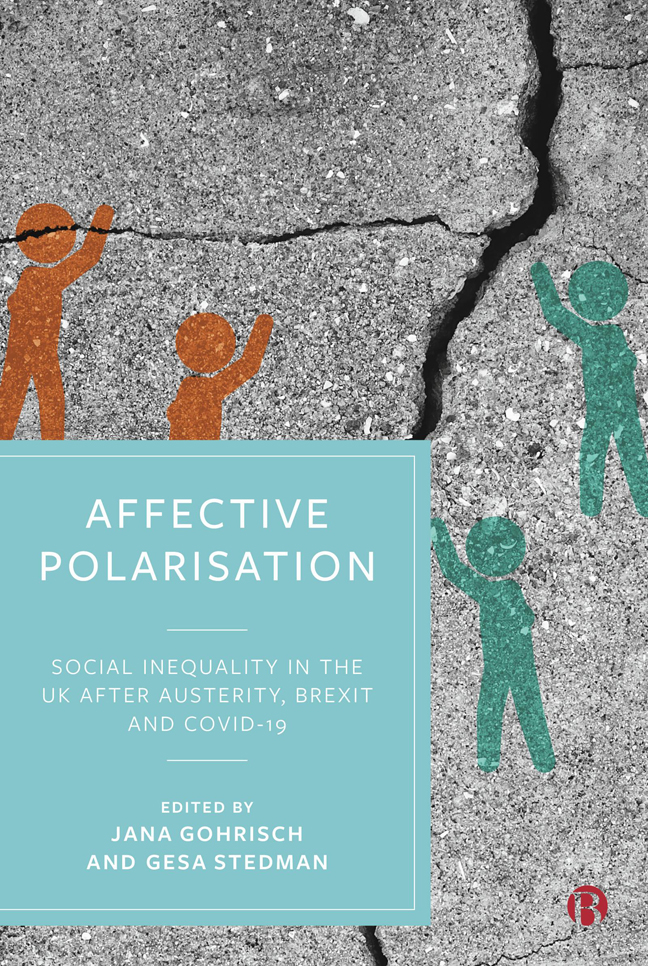Book contents
- Frontmatter
- Contents
- List of Figures, Tables and Boxes
- Notes on Contributors
- Acknowledgements
- Introduction
- 1 The Divided Left in the UK: Partisanship, Ideology and Class after Brexit
- 2 Populism and the People: Elitism, Authoritarianism and Libertarianism
- 3 ‘Coloring the Utterance with Some Kind of Perceivable Affect’: Constructing ‘Country’ and ‘People’ in Speeches by Theresa May and Boris Johnson – A Linguistic Perspective
- 4 The Challenges of Polarisation: Lessons for (Re-)Politicising Inequality across Four English Towns
- 5 “Go Away, But Don't Leave Us”: Affective Polarisation and the Precarisation of Romanian Essential Workers in the UK
- 6 Racialised Affective Polarisation in the UK
- 7 “Now You Have to Listen”: A Historical Analysis of Britain’s Left-Behind Communities
- 8 Britain in a State of Emergency: Studying Ken Loach's Films I, Daniel Blake (2016) and Sorry We Missed You (2019)
- 9 Cloaking Class: Making the Working Class Visible
- 10 Class, Poverty and Inequality in Scotland: Independence and the Creation of Affective Polarisations
- 11 Language and Identity: The Taliesin Tradition
- Conclusion
- Index
1 - The Divided Left in the UK: Partisanship, Ideology and Class after Brexit
Published online by Cambridge University Press: 23 January 2024
- Frontmatter
- Contents
- List of Figures, Tables and Boxes
- Notes on Contributors
- Acknowledgements
- Introduction
- 1 The Divided Left in the UK: Partisanship, Ideology and Class after Brexit
- 2 Populism and the People: Elitism, Authoritarianism and Libertarianism
- 3 ‘Coloring the Utterance with Some Kind of Perceivable Affect’: Constructing ‘Country’ and ‘People’ in Speeches by Theresa May and Boris Johnson – A Linguistic Perspective
- 4 The Challenges of Polarisation: Lessons for (Re-)Politicising Inequality across Four English Towns
- 5 “Go Away, But Don't Leave Us”: Affective Polarisation and the Precarisation of Romanian Essential Workers in the UK
- 6 Racialised Affective Polarisation in the UK
- 7 “Now You Have to Listen”: A Historical Analysis of Britain’s Left-Behind Communities
- 8 Britain in a State of Emergency: Studying Ken Loach's Films I, Daniel Blake (2016) and Sorry We Missed You (2019)
- 9 Cloaking Class: Making the Working Class Visible
- 10 Class, Poverty and Inequality in Scotland: Independence and the Creation of Affective Polarisations
- 11 Language and Identity: The Taliesin Tradition
- Conclusion
- Index
Summary
Introduction
In recent years, the British social and political landscape has been shaken by a series of major upheavals: the 2007–9 Great Recession and the resultant prolonged austerity and social polarisation, the 2014 Scottish independence referendum, the 2016 Brexit referendum and the COVID-19 pandemic. These events have had a great impact on the political system, leading to the long-term dominance of the Conservative Party (Bale, 2017, 2023; Cutts et al, 2020), increased political volatility and participation (Sloam and Henn, 2019; Fieldhouse et al, 2021), the takeover of the Scottish National Party (SNP) in Scotland (Johns and Mitchell, 2016), the realignment of voters and parties along Brexit-related identities (Clarke et al, 2017; Sobolewska and Ford, 2020), a temporary surge of Eurosceptic forces (Ford and Goodwin, 2014; Tournier-Sol, 2021), the rise and fall of Corbynism (Seymour, 2017; Batrouni, 2020; Pogrund and Maguire, 2020; Burton-Cartledge, 2021; Eagleton, 2022), and the withdrawal from the European Union (Fabbrini, 2017, 2020, 2021). Despite some important local successes, particularly in Scotland and Northern Ireland, the UK left has generally failed to benefit from these developments, ending up marginalised in Westminster, politically divided and weaker than ever among working-class communities.
This chapter surveys the current state of the left in the UK through a quantitative analysis of the results of the 2019 general election (Uberoi et al, 2020), the survey data of the British Election Study (BES; Fieldhouse et al, 2020) and other sources. Relying on descriptive statistical methods, it pinpoints its key electoral weaknesses, internal divisions and strategic problems. The first section delimits the boundaries of the UK left and quantifies its present weight within the British electorate according to six indicators. The second section explores its partisan, sociological, ideological and national divisions. The third section analyses the role played by the left in broader trends of ideological and affective polarisation among British voters from 2014 to 2019. The concluding section summarises the main findings and briefly discusses possible avenues for renewal.
What is ‘the left’ in the UK?
The left–right criterion is undisputedly the most popular way to classify the political ideas of thinkers, parties and citizens along a one-dimensional continuum. Originating in the seating arrangement of deputies during the French revolution, this distinction has dominated academic and popular discourse ever since (Fuchs and Klingemann, 1990; Bobbio, 1996; Bakker and Hobolt, 2013).
- Type
- Chapter
- Information
- Affective PolarisationSocial Inequality in the UK after Austerity, Brexit and COVID-19, pp. 11 - 32Publisher: Bristol University PressPrint publication year: 2023



